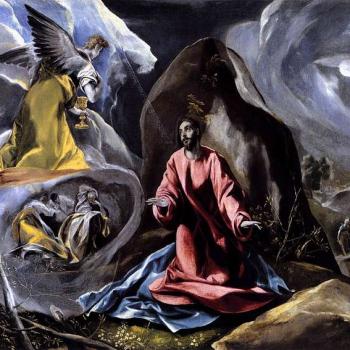As Advent comes to a close, it is fitting to contemplate the climactic moment in the Bible’s description of Christ’s return, the descent of the New Jerusalem, the holy city that comes down from Heaven to be the Bride of Christ, the eternal habitation of the saved (Revelation 21).
I want to focus on a specific detail of this vision that I had never noticed or even heard about before, which was brought up by our pastor and son-in-law Ned Moerbe at our recent Advent Service.
This particular city, described as “having the glory of God, its radiance like a most rare jewel,” (21:11), is measured by an angel: “The city lies foursquare, its length the same as its width. And he measured the city with his rod, 12,000 stadia.[d] Its length and width and height are equal”(21:16).
OK, so what’s a stadia? According to the footnote in the Lutheran Study Bible, “a stadion was about 607 feet or 185 meters.”
Doing the math, 12,000 x 607= 7,284,000 feet. And 7,284,000 divided by 5,280 feet in a mile = 1,379.545 miles. So the New Jersualem, the holy city of God, will have an extension on all four sides of just under 1,400 miles.
The United States is 2,800 miles long, from coast to coast, and 1,582 miles wide, from north to south. So this city that God will make for us would be larger in area than most of the world’s countries.
But “its length and width and height are equal.” This means that the city will also go 1,400 miles into the sky! The boundary of outer space is only 62 miles up. Satellites are in orbit 100-200 miles above the surface of the earth. Now the Moon is much further away, nearly 240,000 miles, but still. . . .
What are we to even imagine about a city that extends so far not only on earth but in the sky? Is it like Whittier, Alaska, the city that consists of one high-rise building? Is it a collection of super-high skyscrapers? Is it separate structures that are suspended in the air, but that our resurrected bodies with new powers will have access to? Or what?
This city, described as a radiant jewel–something small but precious to God–is said to be a vast cube, 1,400 miles on every side! I once read a snarky piece purportedly on the Biblical dimensions of Heaven that concluded that there isn’t much room, so that not many people will get there. But the writer apparently didn’t know how long a stadion is. At over 2.7 billion cubic miles, there should be room for lots of people, living and formerly dead. “In my Father’s house are many rooms,” indeed, as Jesus says of the places He is preparing for us (John 14:2).
(And notice that this isn’t a description of Heaven, the spiritual realm where our souls will be with Lord after we die. Rather, this is city is but a part of the New Earth that God will re-create when Christ returns and the dead will rise with new bodies.)
What are we to make of this staggering imagery? Of course, the Revelation of St. John is a vision, full of unfathomable spiritual imagery and mysterious symbolism. This is not necessarily a literal rendition of what our eternal home will be like. (Then again, maybe it is!)
But if these dimensions are symbolic, what are they symbolic of? And whether they are to be taken literally or figuratively, what do they mean?
Here are some thoughts that this text brings to my mind. . . .
First, this City of God is an opposite parallel to the City of Babel (Genesis 11:1-9). The Babelonians were so proud of themselves and of their technological prowess. “Come, let us build ourselves a city and a tower with its top in the heavens, and let us make a name for ourselves” (11:4). Well, compared to the city that God builds, with its top that really does go far into the heavens, the Tower of Babel was little more than a stack of Legos. This gives us perspective about what human works and endeavors amount to, compared to God’s works and endeavors. And now, today, we are even more impressed with ourselves, thinking our technology will enable us to top the heavens with our own virtual realities–yea, a Metaverse–so that this text can remind us how small, limited, and hubris-ridden we actually are.
That’s Law, making us realize our sinful condition. But there is also Gospel in this text, which I think predominates and is the central meaning, whether the description is literal or symbolic.
The Lutheran Study Bible note to Rev 21:16 notes a connection to the other perfect cube referred to in the Bible: the Holy of Holies in the Temple, which has a length, width, and height of a mere 20 cubits, that is, 30 feet (1 Kings 6:20). But the Temple is described as a copy and shadow of the heavenly things” (Hebrews 8:5).
In the Temple, the Holy of Holies, or, as the ESV puts it, “the most holy place,” is where the Ark of the Covenant, which contains the Ten Commandments, is kept, and where God Himself is mysteriously present (Exodus 25:22). No one can enter there, except the High Priest, who comes in on the Day of Atonement with the blood of the sacrificial scapegoat to intercede for the sins of the people, pouring out the blood onto the “mercy seat” of the ark, between the cherubim of God’s presence and the broken tablets of the Law. This, in turn, was a copy and shadow of Christ’s redemption. “For Christ has entered, not into holy places made with hands, which are copies of the true things, but into heaven itself, now to appear in the presence of God on our behalf” (Hebrews 9:24).
The 1,400 mile cube is the Holy of Holies. On earth, the most holy place was exceedingly small. Unless you were the High Priest, and then only once a year, to enter it meant death. Sinful human beings are consumed by God’s holiness. But now, through Christ and at His return, the true Holy of Holies comes down from Heaven. Now it is vast and spacious. Now all God’s people, in their multitudes throughout history, can not only enter but dwell there with Him forever!
Indeed, this is what the text itself says as the dazzling, awe-inspiring Holy City descends from Heaven to Earth:
And I heard a loud voice from the throne saying, “Behold, the dwelling place of God is with man. He will dwell with them, and they will be his people, and God himself will be with them as their God. He will wipe away every tear from their eyes, and death shall be no more, neither shall there be mourning, nor crying, nor pain anymore, for the former things have passed away.” (Revelation 21:3-4)
The New Jerusalem–the Church, “the Bride, the wife of the Lamb” (21:9)–is the true Holy of Holies, which God brings to earth. He will dwell with us, a reality that has already begun in Jesus Christ. He is Immanuel, meaning “God with Us” (Matthew 1:23),” and He is the Word who was God who “became flesh and dwelt among us” (John 1:1, 14).
And this mysterious image from the Bible evokes the glory that awaits us that we mortals cannot comprehend. The details are meant to stagger our minds and our imaginations, a promise of
“What no eye has seen, nor ear heard,
nor the heart of man imagined,
what God has prepared for those who love him” (1 Corinthians 2:9)
What an appropriate finale to the Bible, tying together the Old Testament and its fulfillment in the New Testament and looking ahead to our own fulfillment in the Church Triumphant!
Image by DigitalArtist via Pixabay

















